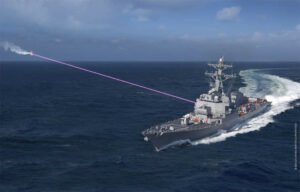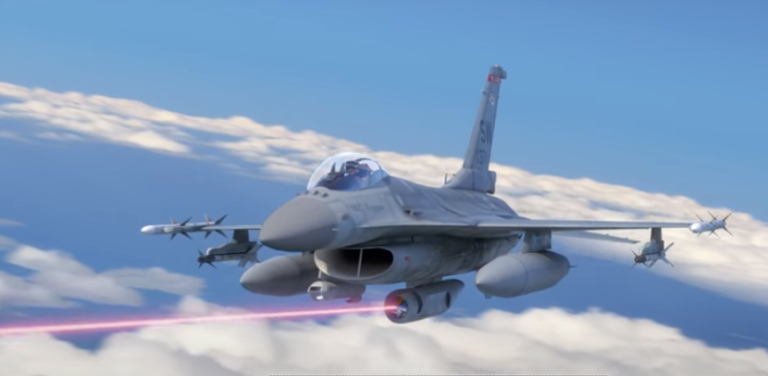The U.S. Air Force is running war game simulations putting cutting-edge fighter-mounted lasers and kinetic energy weapons systems to the test. Known as the Directed Energy and Kinetic Energy Directed Energy Utility Concept Experiment (a.k.a. DEKE DEUCE), the war game simulations from the Air Force Research Labs were designed to determine the effectiveness of advanced laser weapons systems in modern air warfare, especially when combined with traditional kinetic munitions. Following these successful tests, the military branch appears to be moving closer to actual deployment.


LASER WEAPONS SYSTEMS ARE INCREASINGLY IN DEVELOPMENT
Lasers are a staple of science fiction but have yet to become a part of the 21st-century battlefield. The Air Force and U.S. Navy have been testing laser systems since the 1970s, but none of those bulkier systems have made it to actual field deployment.
The Debrief recently reported on a U.S. Navy laser system that successfully blasted a simulated surface drone right out of the water. The Navy recently tested an even higher power laser system that successfully downed winged drones, quadcopters, and even a simulated ballistic missile.
Now, the Air Force is moving their laser systems closer to actual deployment, a move that may permanently affect the modern air combat battle space.
AIR FORCE BATTLE SIMULATIONS COMBINE LASERS WITH KINETIC WEAPONS
According to a press release, the integrated laser and kinetic weapons system test took place in February at Kirkland Air Force base in New Mexico.
“DEKE DEUCE placed pilots, weapon systems officers, and air battle managers in a series of virtual vignettes exploring mission sets that relate to the combined use of DE and KE systems,” the release explains, “tying together previous studies and analysis focused on an airborne high energy laser pod and two future kinetic concepts.”
The primary laser system tested in February was the Lockheed Martin designed Tactical Airborne Laser Weapons System (TALWS). The video from Lockheed Martin shows the effectiveness of this type of system against a wide range of aerial ordnance.
The Air Force is also testing the effectiveness of its Self-Protect High Energy Laser Demonstrator (SHIELD) system. As you can see, this 300kW laser is powerful enough to drop rockets and missiles right out of the sky.
Based on the positive results of the latest simulations run in February, both laser systems show a significant amount of promise. They are likely to continue to move toward actual in-field deployment. Of course, any laser weapon system deployment would not immediately replace traditional kinetic weapons but serve a complementary role.
“DEKE DEUCE gave the Munitions Directorate a great opportunity to put our kinetic weapons concepts in front of the warfighter,” said Rusty Coleman, the unit’s technical advisor for the modeling and simulation team in the release. “It allowed us to see novel employment concepts that we could not have seen otherwise. The pilots virtually flying the aircraft provided feedback beyond what we could have gotten from any other venue.”
Instructor Air Battle Manager, Capt. Scott Seidenberger, from the 552nd Air Control Wing at Tinker AFB, Oklahoma, who was participating in his third DEUCE, agreed with Coleman’s assessment.
“The DEUCE events are highlighting, from an operator perspective, the need for both creative and rapid solutions to the evolving problem sets created by our adversaries,” he said. “Threats are faster, more agile, and vary in number and capability—leveraging directed energy, tailored munitions, and artificial intelligence will continue to be critical for the development of the solutions we need to keep our edge in the era of strategic competition.”
According to Col. Matthew Crowell, the officer who led the team of five aviators virtually operating the laser-equipped aircraft, this testing and simulation process is critical in helping integrate new systems like lasers into the Air Force’s arsenal.
“Experiments like the DEKE DEUCE allow critical collaboration between the warfighter and the developers of our future capabilities,” Crowell said. “It provided an amazing opportunity for both communities to learn from each other and keep our Air Force out in front of our peers with technology.”
AIR FORCE LASERS COMING TO A BATTLEFIELD NEAR YOU
The Air Force and other U.S. armed forces have yet to provide definitive timelines for the deployment of their advanced laser weapons systems. However, given the increasing need for directed energy weapons to combat drone swarms, hypersonic missiles, and other evolving threats, it is likely sooner than later.
“An urgent need exists to rapidly field and integrate viable next-generation weapons, both DE and KE, in response to increasing capabilities and aggressive intentions from our adversaries,” said Dr. Darl Lewis, the DEUCE lead and wargaming principal investigator. “This DEUCE focused on identifying capability and joint integration gaps that can be addressed by systems under consideration, as well as potential future tactics and procedures.”
Connect with author Christopher Plain on Twitter @plain_fiction

